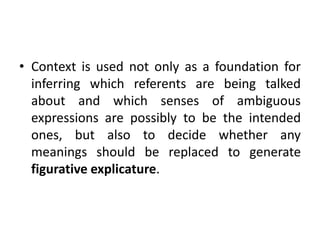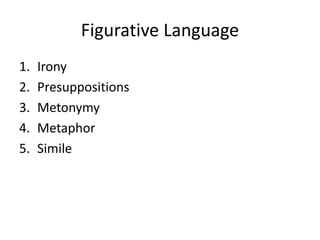Figurative language
- 2. • Figurative interpretation = explicature • It involves treating one or more words as they had meanings different from their literal ones.
- 3. • Context is used not only as a foundation for inferring which referents are being talked about and which senses of ambiguous expressions are possibly to be the intended ones, but also to decide whether any meanings should be replaced to generate figurative explicature.
- 4. Figurative Language 1. Irony 2. Presuppositions 3. Metonymy 4. Metaphor 5. Simile
- 5. Irony • A figure of speech used to express the exact opposite of its literal meaning • E.g. Yay! I love having homework over the weekend.
- 6. Presuppositions • A figurative language about the forecast, conjecture, or preconceptions. Presuppositions occur when the hearer and the speaker have the same compatibility and basic knowledge (common knowledge).
- 7. Presuppostions • Examples 1. Jane no longer writes fiction. Presupposition: Jane once wrote fiction. 2. Have you stopped eating meat? Presupposition: You had once eaten meat. 3. Have you talked to Achmad Yani? Presupposition: Achmad Yani exists.
- 8. Metonymy • A person or object being referred to using as the vehicle a word whose literal denotation is somehow pertinently related. • Metonym vehicles must be distinctive properties of the people or objects referred to. The vehicle must also be relevant in the context of utterance. • The term for a figuratively-used word (or phrase) is vehicle. The vehicles carries the figurative meaning.
- 9. Metonymy 1. The White House declared that we are at war with Mars. “The White House” is a metonymy for “The President”. 2. After leading the rebellion, he seized the throne. “The throne” is a metonymy for “absolute power” of “the power to rule”.
- 10. Metaphor • A metaphor is a figure of speech that compares one thing to another thing. Metaphors do not use the word like or as. • E.g. Yayan has a heart of a lion • The students are busy bees.
- 11. Simile • A comparison of two different things using the words, like or as. • E.g. on her first day of school, Emma was as cool as a cucumber.
- 12. Practice • Answer the questions no 2-4 page 90-91
- 13. • State the vehicles of the following sentences and the meanings. And the type of figurative language. 1. She was a prisoner in her home. 2. Yani is a shining star in our classroom. 3. The information was music to Achmad’s ears. 4. I’ve hot a new set of wheels 5. We need some new blood in the organization. 6. This is my brilliant son who failed out of college. 7. She’s a great singer who sings like a crow.













